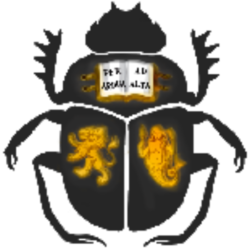So that the greatest number and range of people can enjoy its events, the Egypt Exploration Society (see link below right) has started arranging events outside of London. On Sunday 1st June 2014 they came to Birmingham Museum and Art Gallery (BMAG) and here is a brief summary of the day by BE participant and Birmingham alumna Pam Oak.
After being met in the Round Gallery by Carl Graves (BE member and EES Education and Public Engagement manager), the group of attendees was taken to a room ‘behind the scenes’, where refreshments were provided, for the three talks of the afternoon. Following a short welcome by Carl, Adam Jaffer (the curator in charge of the Ancient Egyptian collection) told us about the origins of the BMAG in 1885 and its acquisitions and exhibits, including how it gathered the 8000 Egyptian objects now in its collection.
The second talk of the afternoon, entitled ‘Prepared for Eternity’, was presented by Bob Loynes from the KNH Centre for Biomedical Egyptian Research at the University of Manchester. Bob is a retired orthopaedic surgeon who from childhood had been interested in Ancient Egypt. Using his life skills he decided to further his knowledge of Egyptology by studying various mummies. After a brief, but very clear explanation of computer axial tomography (CAT) scanning and its history, he then went on to tell us of his research with three mummies in the BMAG collection and he shared his findings with us. The first was Padimut, a Twentieth/Twenty-first Dynasty mummy from Thebes which contained some subcutaneous throat packing. Next was Namenkhetamun, again from Thebes but dated to the Twenty-sixth Dynasty. Her coffin bears the title ‘Chantress in the temple of Amun.’ However, there was a surprise when this mummy was scanned – it had a phallus! The final mummy was Graeco-Roman. The scan showed metal pieces in the skull, possibly small chips off the tools used for excerebration. Throughout the talk Bob showed pictures of scans taken by earlier Egyptologists which enabled us to see how much progress has been made in this field of research.
Bob’s talk was followed by a viewing of the Egyptian gallery in BMAG. Adam Jaffer estimated that around 5% of their collection is on show, the rest being stored and displayed in the Museum Collection Centre in Duddeston.
Carl delivered the final talk of the afternoon giving us a brief overview of the EES in Birmingham and its supplying of artefacts to the BMAG, which can be traced through the materials in the EES archives – excavation notebooks, letters, accession records, drawings, photographs and so on. He brought with him relevant log sheets from the archives for us to see.
The afternoon concluded with a handling session of genuine Egyptian artefacts from BMAG which proved to be a popular experience: figurines, pottery, amulets and other small objects. Each participant left with a complimentary copy of World Art from Birmingham Museums and Art Gallery. Altogether, it was an interesting and informative afternoon and I am looking forward to the next one.
